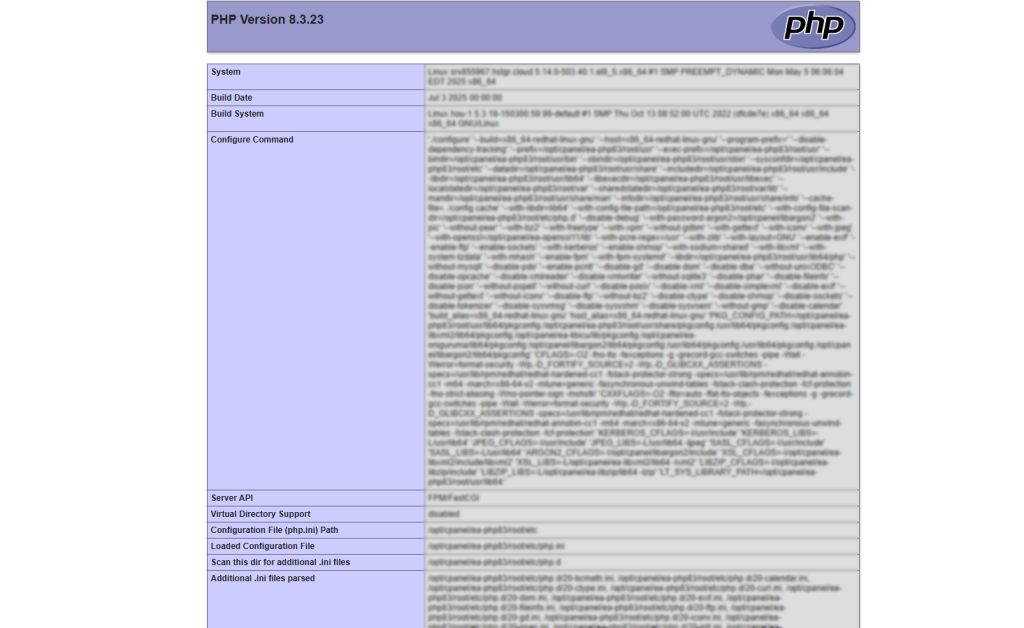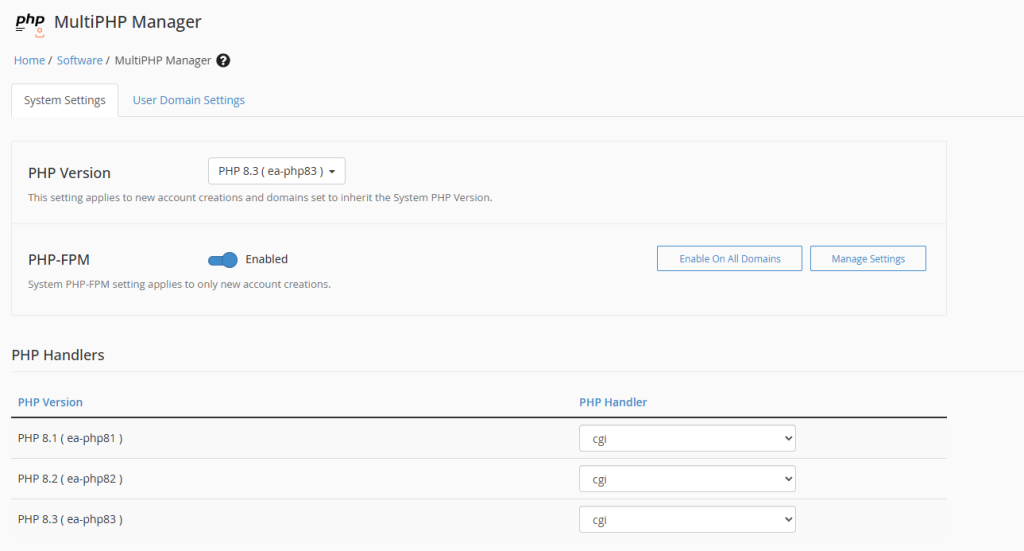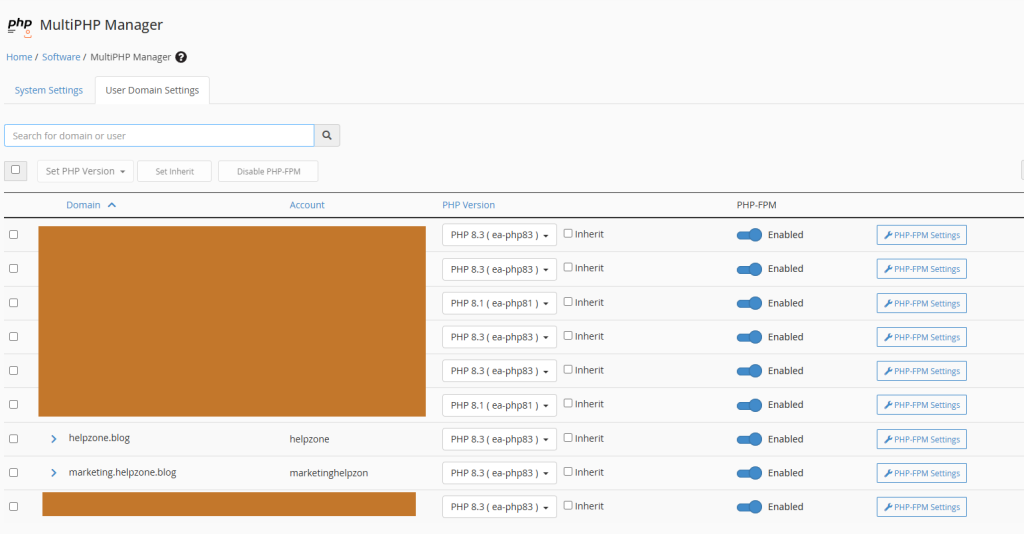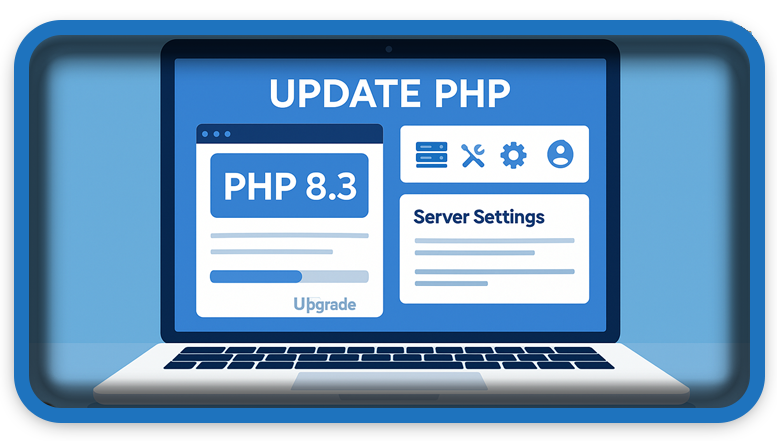⏲️ Estimated reading time: 5 min
Update PHP to the Latest Version for WordPress Performance and Security. Running WordPress on an outdated PHP version slows your site and increases risk. This guide explains why updating PHP is essential, and how to upgrade safely with MultiPHP Manager system settings and domain-level settings in cPanel and WHM.
Why Updating PHP Matters for WordPress
PHP is the backbone of WordPress. Every time someone visits your site, PHP runs behind the scenes to generate pages dynamically. Outdated versions put your website at risk and affect performance.
Benefits of updating PHP:
- Faster websites – PHP 8.2/8.3 is significantly faster than 7.x and 8.0/8.1.
- Better security – older versions (like PHP 7.4, 8.0, 8.1) are already in security-fix-only mode or completely unsupported.
- Compatibility – modern themes and plugins (e.g., WooCommerce, Elementor, Yoast SEO) are optimized for PHP 8.2+.
- Future-proofing – ensures your site will continue working as plugin developers drop support for old versions.
Checking Your Current PHP Version
There are several ways to see what PHP version your site uses:
- WordPress Dashboard → Tools → Site Health → Info → Server → PHP Version.
- cPanel → MultiPHP Manager – check which version is applied to your domain.
- phpinfo.php file – create a file in your domain root with:
<?php
phpinfo();
Open it in your browser at yourdomain.com/phpinfo.php. Always delete it afterward for security.

Understanding MultiPHP Manager in cPanel & WHM
MultiPHP Manager lets you control PHP versions at two levels:
1. System PHP Version (Global Setting)
- Found in WHM → MultiPHP Manager (System PHP Version).
- Defines the default PHP version for the entire server.
- Any domain set to inherit will use this version.
- Example: If the system PHP version is set to ea-php83, then all domains with “inherit” will run on PHP 8.3.
2. Domain PHP Version (Per-Domain Setting)
- Found in cPanel → MultiPHP Manager (User Level).
- Allows you to select a specific PHP version for a single domain.
- Overrides the system default.
- Example: You can run
example.comon PHP 8.3 andshop.example.comon PHP 8.2 for compatibility.

This flexibility is critical when managing multiple websites with different plugin/theme requirements.
How to Update PHP Using MultiPHP Manager
Updating System PHP Version (Global for All Inherited Domains)
- Log in to WHM as root.
- Go to Software → EasyApache 4.
- Ensure ea-php83 is installed. If not, enable it and click Provision.
- Go to WHM → MultiPHP Manager.
- At the top, under System PHP Version, select ea-php83.
- Click Apply.
✅ Now, all domains set to inherit will automatically use PHP 8.3.

Updating PHP for a Specific Domain
- Log in to cPanel.
- Go to Software → MultiPHP Manager.
- In the domain list, select the checkbox for your domain (e.g.,
yourdomain.com). - On the right, choose the PHP version (ea-php82 or ea-php83).
- Click Apply.
✅ This forces your domain to always use that PHP version, regardless of the system default.
When to Use “Inherit” vs Explicit Version
- Use Inherit:
- When you want all your sites to update automatically when you change the global system version.
- Best for managing many domains consistently.
- Use Explicit Version:
- When a site requires a specific PHP version due to plugin or theme compatibility.
- Example: If WooCommerce works on PHP 8.3 but a custom theme fails, you can set that domain explicitly to PHP 8.2.
Updating PHP on a VPS via SSH
For VPS with AlmaLinux / CentOS, you can manage PHP versions directly via terminal:
# Reset and enable the PHP 8.3 stream
sudo dnf module reset php -y
sudo dnf module enable php:8.3 -y
# Install PHP 8.3 with common extensions
sudo dnf install php php-cli php-common php-mysqlnd php-xml php-gd php-curl php-mbstring php-zip -y
# Restart Apache or PHP-FPM
sudo systemctl restart httpd
sudo systemctl restart php-fpm
This makes PHP 8.3 available, after which you can assign it in WHM → EasyApache 4 and MultiPHP Manager.
Best Practices Before Updating
- Backup everything (files + database).
- Update WordPress core, themes, and plugins first.
- Check compatibility for mission-critical plugins.
- Test on staging site if possible.
- Monitor error logs after switching.
Troubleshooting After Upgrade
- 500 Internal Server Error / White Screen → check
error_login cPanel. - Plugin conflicts → temporarily switch the domain back to PHP 8.2 until developer releases update.
- Performance issues → enable PHP-FPM in cPanel for better speed.
Final Thoughts
Updating PHP is one of the easiest yet most impactful upgrades you can make for your WordPress website. Using MultiPHP Manager, you can:
- Set a global System PHP Version for all inherited domains.
- Override specific domains individually when compatibility issues arise.
By upgrading to PHP 8.3, you gain faster performance, stronger security, and full compatibility with the latest WordPress ecosystem.
🔔 For more tutorials like this, consider subscribing to our blog.
📩 Do you have questions or suggestions? Leave a comment or contact us!
🏷️ Tags: update php wordpress, upgrade php cpanel, php 8.3 wordpress, whm php update, site health php, wordpress performance, php security, php compatibility, vps php upgrade, multiphp manager
📢 Hashtags: #WordPress #PHP #UpdatePHP #cPanel #WHM #VPS #Performance #SiteSecurity #MultiPHP #WebHosting
Only logged-in users can submit reports.
Discover more from HelpZone
Subscribe to get the latest posts sent to your email.

